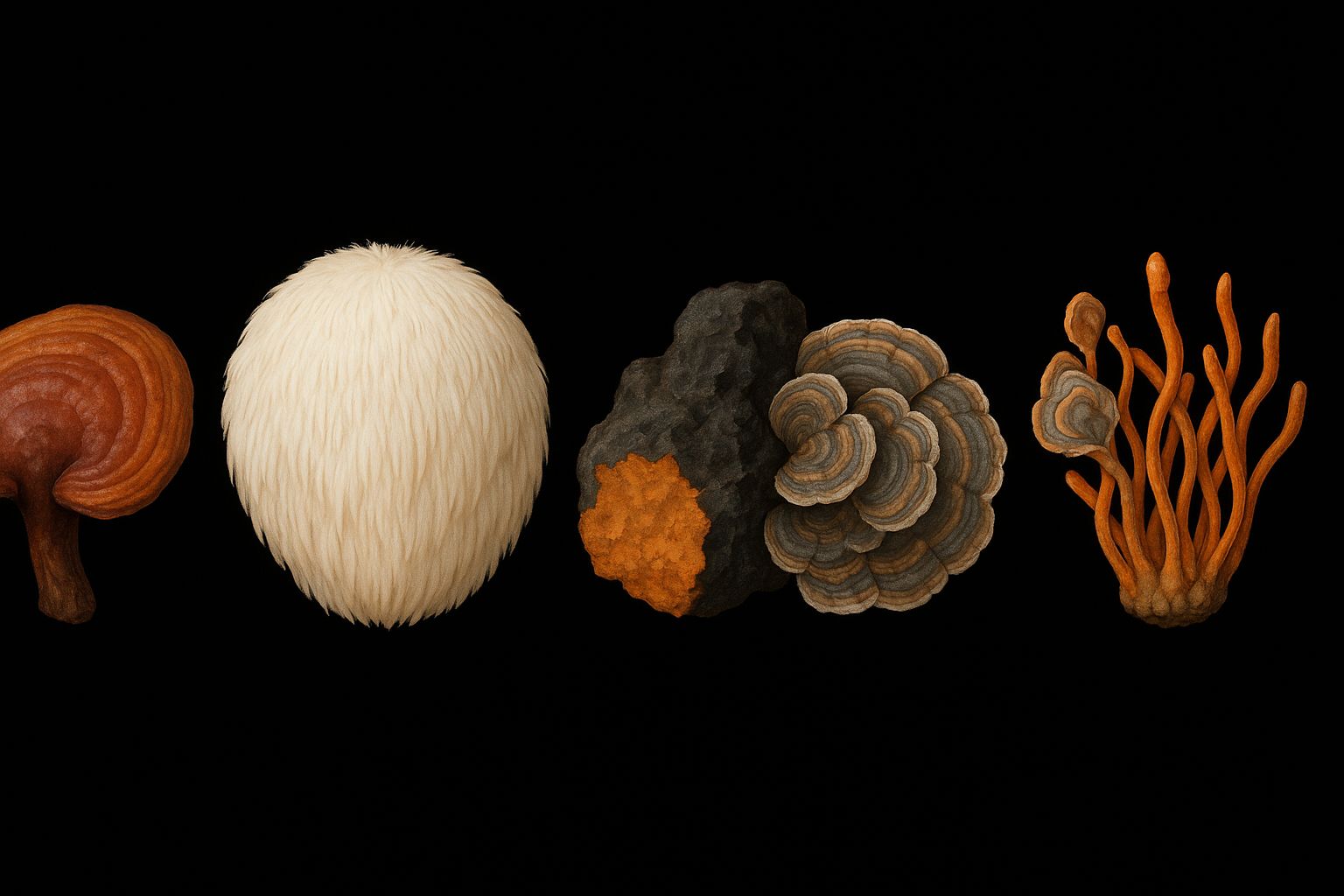- 40-something
- Posts
- The best medicinal mushrooms to add to your diet
The best medicinal mushrooms to add to your diet
5 mushrooms that are straight out of nature’s medicine cabinet.
Over the past few years, I’ve slowly discovered the world of medicinal mushrooms—not the psychedelic kind (though that's a fascinating topic too), but the functional fungi that support immunity, energy, brain health, and overall balance. They’ve been used in traditional Chinese medicine and other healing systems for centuries, but now they're making their way into smoothies, coffees, and supplements everywhere.
Here are the top medicinal mushrooms that I’ve either already tried and loved or am waiting to get my hands on—along with how to recognise them, what they’re good for, and how to prepare them.

1. Reishi – The Queen of Calm
How to recognise It: Reishi (Ganoderma lucidum) grows like a fan-shaped shelf on decaying hardwood trees. It has a shiny, lacquered surface that looks almost varnished—usually deep red or brown with golden edges.
Why love it: Reishi is a go-to when you feel stressed or can’t sleep. It's known for calming the nervous system, improving sleep, and supporting immunity. It's also a powerful adaptogen, helping the body respond to physical and emotional stress.
How to use it: Reishi is too tough and bitter to eat like a button mushroom, so simmer dried slices in water for 30–45 minutes to make tea or use a powdered extract in evening drinks. A reishi hot chocolate with oat milk and a hint of cinnamon is pure serenity in a cup.
2. Lion’s Mane – The Brain Booster
How to recognise it: Lion’s Mane (Hericium erinaceus) looks like a white pom-pom or shaggy icicle. It grows on dead or dying hardwood trees and has long, cascading spines.
Why love it: This one’s for the thinkers. Lion’s Mane is known for supporting cognitive function, memory, and focus. It promotes the production of NGF (nerve growth factor), which supports the brain and nervous system.
How to use It: Lion’s Mane has a delicate, seafood-like texture—some say it tastes like crab or lobster. Try it sautéed with garlic. If you can’t find it fresh, powdered versions go beautifully in coffee or smoothies.
3. Chaga – The Antioxidant Powerhouse
How to recognise it: Chaga (Inonotus obliquus) looks like burnt charcoal growing on birch trees. The outer surface is black and crusty, while the inside is a warm, rusty orange.
Why love it: Reach for Chaga when you want an immunity boost or need extra energy without caffeine. It’s one of the richest sources of antioxidants in the natural world, helping the body fight oxidative stress.
How to use it: Steep chunks or powder in hot water for an earthy, coffee-like tea. Chaga doesn’t taste mushroomy at all—it’s more like a mild, woody herbal brew. Add a dash of cinnamon and honey for a delicious daily ritual.
4. Turkey Tail – The Gut Guardian
How to recognise it: Turkey Tail (Trametes versicolor) is stunning—it fans out like a turkey’s tail with bands of colour: brown, grey, blue, even green. It grows on decaying logs all over the world.
Why love it: Turkey Tail is a go-to for gut and immune support. It contains prebiotics to feed good gut bacteria and powerful polysaccharides like PSK and PSP that have been studied for cancer-fighting properties.
How to use it: Like Reishi, it’s too woody to eat directly. Simmer it to make tea or buy it as an extract powder. It’s flavourless enough to disappear into soups, stews, or bone broth—perfect for winter wellness.
5. Cordyceps – The Energy Elixir
How to recognise it: Cordyceps (Cordyceps militaris) looks like a bright orange club or caterpillar-shaped fungus. Wild Cordyceps sinensis famously grows out of insect larvae (yes, kind of gross but fascinating), but most modern versions are cultivated without bugs.
Why love it: Cordyceps is a natural pre-workout. It supports oxygen utilisation and stamina, making it great for endurance and recovery. It also helps regulate energy and libido.
How to use it: Cordyceps powder goes well in morning coffee or matcha for a clean, crash-free lift. Also try using it in homemade energy balls with dates, cacao, and almond butter—super simple and effective.
If you’re curious about medicinal mushrooms, you don’t need to forage in the wild (unless you’re trained). Start with organic mushroom powders, capsules, or tinctures from reputable brands. Look for “dual extraction” to get both water- and fat-soluble compounds.
Start slow… one mushroom at a time, and listen to your body. These are not quick fixes, but they can offer powerful, long-term support for your health and wellbeing. Plus, they bring you closer to nature in the most magical way.
Remember: Mushrooms are amazing little fun guys 🍄
Umayya xx